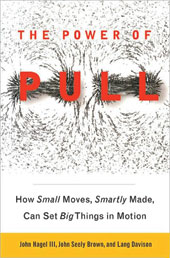Are You ‘Pushing’ in a ‘Pull’ World?
A new book argues that companies need to adapt to a fundamental change in business.

Courtesy of New York: Basic Books.
Marketers have increasingly recognized that their world has been changing from “push” to “pull.” Traditionally, they could push advertising and other marketing content toward potential customers to tout new products or services. Now, consumers have grown accustomed to pulling that information in for themselves by, for instance, surfing the Web. And that fundamental shift from push to pull is not limited to marketing; it’s occurring in all aspects of business, from human resources to research and development. At least that’s the contention of a provocative new book, The Power of Pull: How Small Moves, Smartly Made, Can Set Big Things in Motion, by John Hagel III, John Seely Brown and Lang Davison (New York: Basic Books, 2010).
The authors, who are all affiliated with the Deloitte Center for the Edge, define pull as “the ability to draw out people and resources as needed to address opportunities and challenges.” Some of the characteristics of pull are collaboration, flexibility and bottom-up initiatives. Push, on the other hand, relies on centralized control, conformity and top-down directives. The difference between the two mind-sets affects nearly every aspect of a business. Take how information is handled. Push managers focus on acquiring stocks of knowledge — a sales organization, for instance, might hoard customer data, even keeping that information from other departments within the same company. In contrast, managers in pull organizations are much more concerned about flows of knowledge — having and providing access to important information across departments and even from one company to another.
By now, most managers have heard of at least some aspects of the pull phenomenon. Companies are aware of the ways in which the Web and other information technologies have enhanced the grassroots power of customers and employees. And business gurus have been advocating for years that organizations need to become more agile and less top-down. Moreover, the importance of information flow is a central idea of “open innovation,” the concept that companies should leverage both internal and external resources in bringing new technologies to market. But the beauty of The Power of Pull is that the authors bring such seemingly disparate ideas into one simple, overarching imperative: Stop pushing; start pulling.

Comments (2)
openworld
openworld